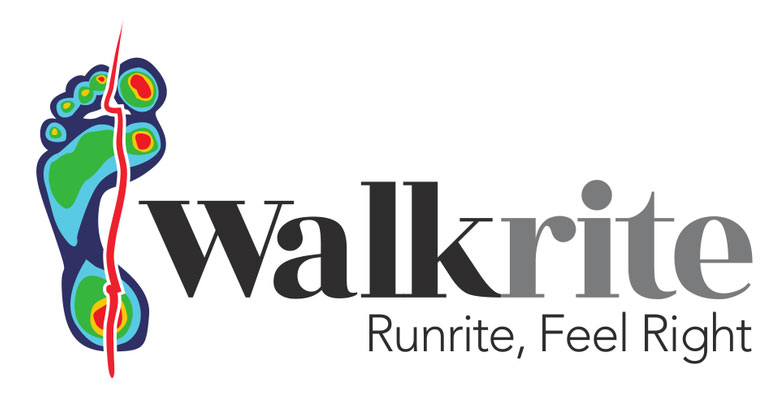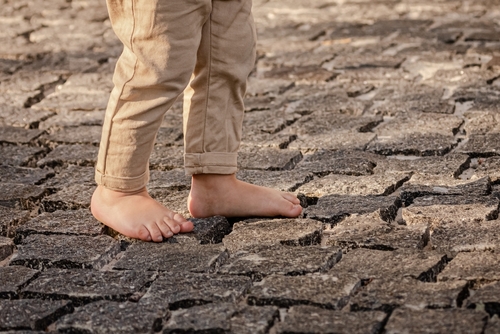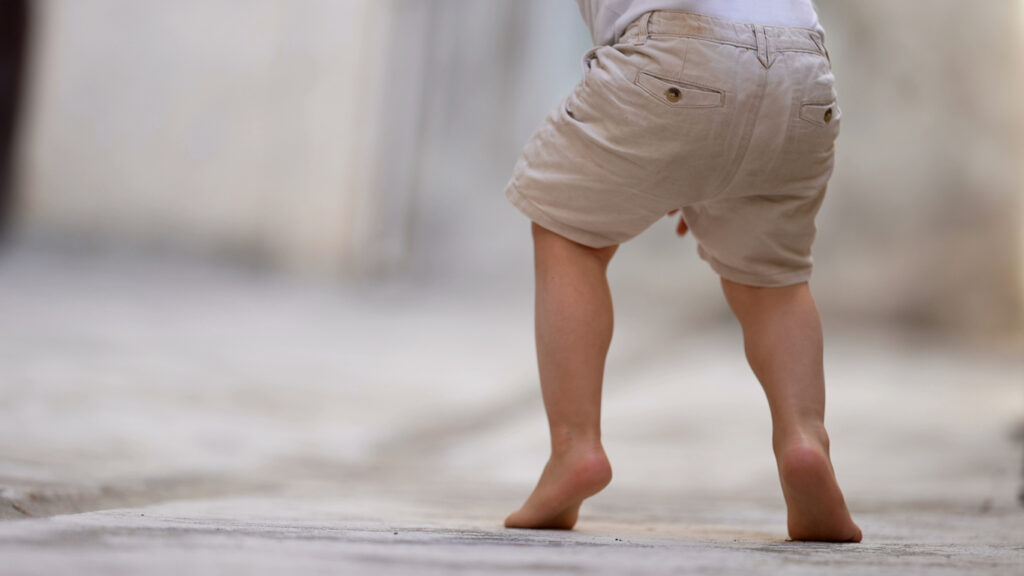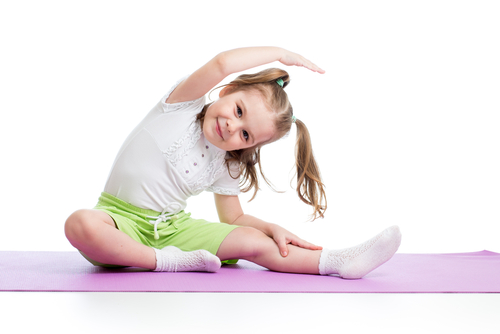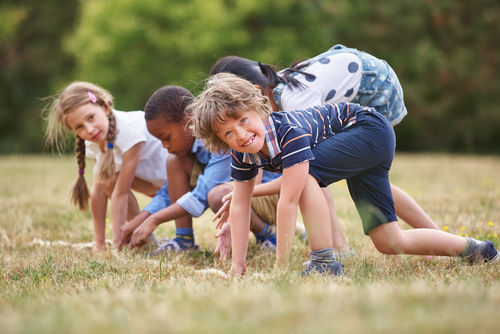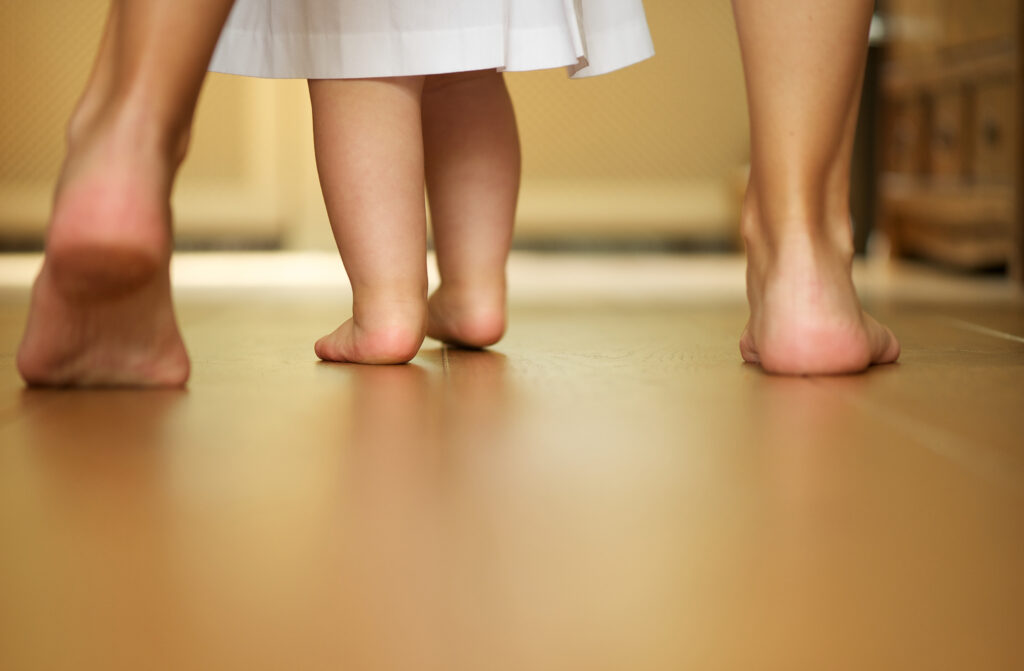
Foot and ankle pain is common in children and can have a huge impact on a child’s quality of life (1). It is important to recognise that when a child is born the foot is only just starting to form and develop and is very different from an adult foot.
Foot development
At birth a foot only contains 22 partly developed bones as opposed to the 26 bones of an adult foot. Baby’s foot bones have gaps between and are cartilaginous, which means they are soft and malleable. Therefore, during early years, it is important to ensure that garments and footwear are well-fitting and not too tight, as they may alter the natural shape of the child’s foot.
Children are born with flexible flat feet and progressively develop an arch over the first decade of life (2). Changes will start to develop slowly as the child begins to walk unsupported and the foot will start to look a little more like an adult foot. As a child grows and develops, the bones of the legs and feet rotate as they grow, up until skeletal maturity (around 18 years of age). When injury occurs or growth or development is affected, then signs and symptoms may arise.
- At birth the foot contains 22 partly developed soft bones – correct development can be restricted by tight fitting garments
- The arch of the foot may start forming around 3 years but will depend on weight-bearing activities
- At 8 years the growth plates are forming and the bones are fusing together
- At 18 years the foot will be fully developed with 26 bones
Walking development milestones
- At 3 months a baby may begin to press their legs against your lap when holding them
- At 6 months old a child will start to bounce up and down when held
- Most 12 month old’s stand up and cruise along furniture – their legs may be more bowed at this age
- 12-18 month old’s walk / run with fewer falls
- Your child at 2 years may begin to walk smoothly, turn corners, run and climb
- 3 year old’s begin to be able to stand on one foot
- 4 year old’s are able to do more on one leg, hop and jump over objects
- 5 year old’s can skip and jump forwards and walk backwards toe to heel
- 6 year old’s can run lightly on their toes, walk on a balance beam and demonstrate more mature jumping and running abilities
- After 6 years old, the motor nervous system should have fully developed and no further milestones are expected to be achieved after this age as they continue then to develop into adulthood
Common foot complaints in children
- Toe deformities such as crossing over or bent toes
- Bunions
- Ingrown toenails
- Verruca
- Delayed walking and / or development
- Flat feet
- Tip-toe walking
- In-toed / out-toed walking
- Pain (in feet / ankles / legs / knees)
- Sports / activity injuries e.g. fractures and sprains
- Heel pain
What’s not normal
There are a variety of factors that can impact a child’s development from physical injury, genetic predisposition, nutrient deficiencies to neurological causes and more which can lead to:
- Toe deformities – these are not a normal part of development, especially if there is a noticeable difference in comparison to the other side, sudden changes occur, or the foot shape alters significantly and looks different to the other foot
- Unusual lumps and bumps, especially if they are not present on the other foot
- Bunions (when the big toe deviates towards the second toe creating a more prominent area on the inside of the foot) – this can be familial and can cause pain and irritation if rubbing on footwear
- Asymmetry or differences between either side of the body, for example if one foot is a very different, shape or size to the other
- Differences in muscle size or development in comparison to the other side
- A child not meeting developmental milestones / keeping up with their peers as movement is not developing normally
- Persistent pain preventing them from participating in activity – this should not be dismissed as ‘growing pains’ as it could be something more serious such as cancers e.g. leukaemia, vitamin D deficiency or a failure of the foot bones to properly form and separate from each other
If your child has any of the above or you are concerned, contact us or book online here.
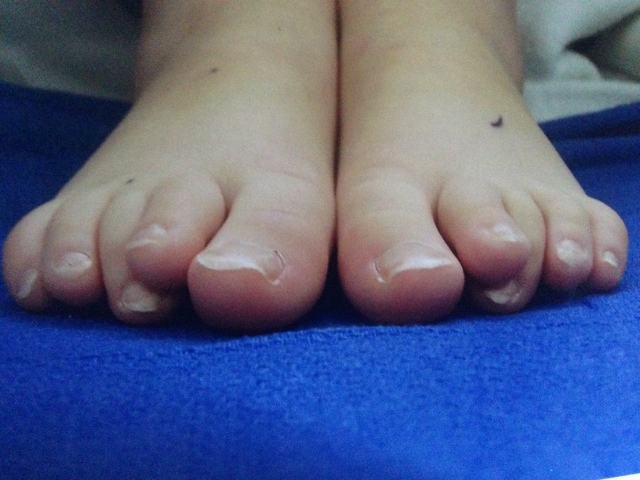
Low arches (flat feet) are a common parental concern. However, in most cases, flat feet in children is part of normal development and does not need treatment or anything to support the foot so long as the child is not in pain and is developing normally. If a child’s foot shape changes suddenly or is associated with persistent pain, fatigue, limping, activity avoidance or tripping, having them checked is important.
Tiptoe walking can be part of normal development and is normal to see up until the age of primary school. If limping or tiptoeing occurs suddenly, is one-sided or is painful, further investigation is warranted.
As children’s limbs grow, the bones also rotate at various stages and therefore in-toeing, out-toeing, knock knees and bowed legs can be seen as part of normal development up until the end of secondary school and should gradually resolve on its own. If you notice that the positioning of the legs and feet is excessive, progressively deteriorating or associated with pain or other symptoms then assessment is recommended.
When it’s not growing pains!
It is easy to dismiss pain in growing children as ‘growing pains’, with the assumption that the pain will go away on its own. However, children do develop serious conditions such as bone tumours, leukaemia, neurological problems and vitamin D deficiency that can present similarly. The cause of growing pains is unknown. Theories as to why they occur range from mechanical / postural problems, hypermobility, blood perfusion changes to the muscles, tiredness, stress and lower pain thresholds. Symptoms typically are:
- Pain at night that can wake the child
- Pain focussed on muscles more than joints
- Affects both limbs though can be in different locations on each
- Severity of pain can vary from mild to very severe
- Duration of pain is between 30 mins to 2 + hours but usually resolved in the morning
- The pain at night does not lead to pain in the same areas during the day or cause limping
If the pain is in a joint, on one side only, focussing in the same area, worsening or leading to pain and limping during the day, this is not growing pains and needs further assessment.
When dealing with pain in children, the most important part of any assessment is taking a good history of the complaint. By doing this, we can make a decision as to whether this is a condition that needs further investigation or onward referral to other Paediatric services. A thorough assessment is also vital to determine if the child is developing normally and to identify the likely cause of the problem. Assessment includes:
- Biomechanical assessment and video gait analysis
- Assessment of neurological development and development milestones
- Foot measurements
- Footwear assessment
Treatments
- Exercise therapy & gait re-training
- Strapping for toes
- Foot orthoses and ankle-foot orthoses
- Ingrown nail and verruca treatments
We also work closely with a larger multi-disciplinary team of Paediatric Orthopaedic Surgeons and Physios, so if further treatment is required, we are able to refer on and work in partnership to deliver the care that’s required.
Helping normal foot development at home
At an early age allow your child to play barefoot where safe, as it will help the foot and lower limb to develop without restriction. Choosing footwear can be difficult but ensure you have both of your child’s feet measured regularly and select shoes that fit the larger foot. Shoes should be light, well-fitting and have about 0.5cm gap at the end of the shoe. Try to select footwear based on how they fit your child’s foot, particularly ensuring the width of the toe area is adequate. Foot-shaped shoes are wider at the toes and will mean less pressure on the toes when they are developing. Staying in a shoe like this for as long as possible (after the age of 8 at least) gives the best chance of preventing the foot being shaped by the shoe. Avoid sloppy shoes like crocs or slippers. If your child is participating in more demanding activities, it is recommended that children have more supportive footwear, with fastenings and an adequate sole.
Vitamin D is essential for skeletal growth and maintaining bone health amongst many other functions. Without adequate Vitamin D, a child may develop rickets, which can cause pain and bone deformities such as bowed legs. It is estimated around 1 in 6 adults and almost 20% of children in the UK have low vitamin D levels. The Department of Health and Social Care recommends that all adults and children should be supplementing vitamin D. You can find more information on the NHS healthy start website (4).
Making sure your child is active and has enough sleep is also important for healthy development. If you would like guidance on the recommended levels of activity and sleep for your child, please visit the World Health Organisation website for age specific and up to date information (3).
If you would like any further information about what is normal or not normal in the growing foot or to make an appointment, please contact us here.
References
- Fuglkjær, S., Dissing, K.B. and Hestbæk, L (2017). Prevalence and incidence of musculoskeletal extremity complaints in children and adolescents. A systematic review. BMC Musculoskeletal Disorders, 18(1). doi:https://doi.org/10.1186/s12891-017-1771-2.
- Uden, H., Scharfbillig, R. and Causby, R (2017). The typically developing paediatric foot: how flat should it be? A systematic review. Journal of Foot and Ankle Research, 10(1). doi:https://doi.org/10.1186/s13047-017-0218-1.
- WHO (2020) WHO guidelines on physical activity and sedentary behaviour. [online] Available at: https://www.who.int/publications/i/item/9789240015128.
- www.healthystart.nhs.uk. (n.d.). Collecting your Healthy Start vitamins – Get help to buy food and milk (Healthy Start). [online] Available at: https://www.healthystart.nhs.uk/getting-vitamins/.
